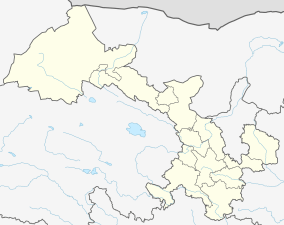Jonê County
Jonê County (also Cone, Chone, Choni; Tibetan: ཅོ་ནེ་རྫོང་།, Wylie: co-ne rdzong, ZYPY: Jonê Zong ; local pronunciation: /tɕɔᴸnɛ/; Chinese: 卓尼县; pinyin: Zhuōní Xiàn) is an administrative district in the Gannan Tibetan Autonomous Prefecture, Gansu Province, China. It is one of 58 counties of Gansu. It is part of the Gannan Prefecture. Its postal code is 747600. Its area is 4,954 km2 (1,913 sq mi), and its population is over 100,000 people. It is administered from Jonê Town.[1]
Jonê County 卓尼县 · ཅོ་ནེ་རྫོང་། | |
|---|---|
County | |
.png) Jonê (pink) within Gannan Tibetan Autonomous Prefecture (yellow) and Gansu (grey) | |
 Jonê Location of the seat in Gansu | |
| Coordinates: 34°35′N 103°30′E | |
| Country | People's Republic of China |
| Province | Gansu |
| Autonomous prefecture | Gannan |
| Seat | Jonê Town |
| Time zone | UTC+8 (China Standard) |
Description
The county covers both banks of the middle section of the Lu-chu. The country town and adjacent Jonê Monastery are on the north bank. The side valleys on the southern side used to be branches of the ancient kingdom of Jonê.[1]
Historical Tibetan Yang Surname Zhouni Tusi
Among Tibetan at Amdo, Jonê exist The Zhouni Tusi (Chinese: 卓尼土司), ruled by the Tibetan Ga clan or Mandarin Chinese Yang (杨) clan, was a Tusi chiefdom kingdom called Zhouni Kingdom, Choni Kingdom, or Jonê Kingdom ruled by the Gatsang (dga' tshang) family at Tibet. In 1404, whereupon they informed the Ming Emperor Yongle of this fact and were recognized as local rulers, and were given a seal of authority and the surname Yang (杨). The Yangs ruled Zhouni from 1404 until 1949.[2][3]
List of Kings of Jonê
There are list kings of Jonê Kingdom:[4][5]
- ཅོ་ནེ་རྒྱལ་པོ་ཤིས་བསྡུས།
- ཅོ་ནེ་རྒྱལ་པོ་བཙན་པོ།
- ཅོ་ནེ་རྒྱལ་པོ་བཀྲ་ཤིས།
- ཅོ་ནེ་རྒྱལ་པོ་དགའ་སྐྱེད།
- ཅོ་ནེ་རྒྱལ་པོ་དབང་ཕྱུག named 杨洪; Yáng Hóng
- ཅོ་ནེ་རྒྱལ་པོ་ཡང་དྲིན། named 杨臻; Yáng Zhēn
- ཅོ་ནེ་རྒྱལ་པོ་ཡང་ཚེ་མེས། named 杨葵明; Yáng Kuímíng
- ཅོ་ནེ་རྒྱལ་པོ་ཡང་གོ་ལུང་། named 杨国龙; Yáng Guólóng
- ཅོ་ནེ་རྒྱལ་པོ་ཚེ་དབང་དོན་གྲུབ། named 杨朝梁; Yáng Cháoliáng
- ཅོ་ནེ་རྒྱལ་པོ་བློ་བཟང་དོན་གྲུབ། named 杨威; Yáng Wēi
- ཅོ་ནེ་རྒྱལ་པོ་མང་སྲོལ་མགོན་པོ། named 杨汝松; Yáng Rǔsōng
- ཅོ་ནེ་རྒྱལ་པོ་འཇམ་དབྱངས་ནོར་བུ། named 杨冲霄; Yáng Chōngxiāo
- ཅོ་ནེ་རྒྱལ་པོ་བསོད་ནམས་ཆོས་འཕེལ། named 杨昭; Yáng Zhāo
- ཅོ་ནེ་རྒྱལ་པོ་བསྟན་སྲུང་ཚེ་རིང་། named 杨声; Yáng Shēng
- ཅོ་ནེ་རྒྱལ་པོ་བསྟན་འཛིན་རིན་ཆེན་ཆོས་སྐྱབས། named 杨宗业; Yáng Zōngyè
- ཅོ་ནེ་རྒྱལ་པོ་ཆོས་སྐྱབས་འགྱུར་མེད་རྡོ་རྗེ། named 杨宗基; Yáng Zōngjī
- ཅོ་ནེ་རྒྱལ་པོ་རིན་ཆེན་བསྟན་འཛིན་འཕྲིན་ལས་རྡོ་རྗེ། named 杨元; Yáng Yuán
- ཅོ་ནེ་རྒྱལ་པོ་ཚེ་དབང་བསོད་ནམས་རྡོ་རྗེ། named 杨作霖; Yáng Zuòlín
- ཅོ་ནེ་རྒྱལ་པོ་བློ་བཟང་བསྟན་འཛིན་རྣམ་རྒྱལ་རྡོ་རྗེ། named 杨积庆; Yáng Jīqìng
- ཅོ་ནེ་རྒྱལ་པོ་པད་མ་དབང་ཕྱུག named 杨复兴; Yáng Fùxīng
History
- "There are traditions of Tibetan soldiers left behind [after the late 10th century] at several border outposts, such as Jonê, where they established viable settlements, and of the remaining Tibetan conscript troops, called the Wun Mo, carving out considerable territory for themselves until they were perhaps absorbed into that amalgam of people of Tibetan stock, which came to form the Hsi Hsia Kingdom (982—1224)."[6]
Jonê was part of a separate kingdom formed, according to legend, after its invasion by warriors who migrated across the mountains from Szechuan conquering the local tribes in 1404. The contemporary descendants of the Jonê royal line claim that their line is Tibetan, and that their ancestors migrated from central Tibet through Sichuan.
The Yongle Emperor (May 2, 1360 – August 12, 1424) named one of these invading warriors hereditary chief (tusi) called Zhouni Tusi (卓尼土司), bestowing the family name of "Yang" ("杨") and an imperial seal upon his line. The Jonê king (co-ne rgyal-po) established a palace on the north bank of the Tao River. The family holding the Yang seal continued to rule over 48 Tibetan clans in Jonê as an autonomous kingdom from the early 15th century for 23 generations, until 1928, when it was placed under the control of the Lanchow government.[7] In the late Qing Dynasty and Republican Period, many nomadic regions had considerable de facto independence,[8] despite the claims and perspective of the Chinese rulers.[2]
Among the six monasteries in the county, all of them Tibetan Geluk establishments, is the great Jonê Monastery.[1]
The American botanist Joseph Rock spent almost 2 years in Jonê ("Choni", in his spelling) in 1925-26. He resided in the compound of the local chief (the 19th-generation tusi Yang Jiqing (杨积庆)[9]), making it the base for his exploration of southern Gansu and eastern Qinghai. His account of the culture of this "almost unknown Tibetan principality", as he described it, illustrated with color photographs, was published in the National Geographic.[10][11][12]
As of 2012, Jonê was apparently closed to foreign visitors.[10]
Footnotes
- Dorje (2009), p. 812.
- Tibetan Historical Polities: , retrieved 19 Aug 2017
- Tibetan, Jone in China: , retrieved 19 Aug 2017
- Buddhist Digital Resource Center: , retrieved 19 Aug 2017
- https://treasuryoflives.org, retrieved 19 Aug 2017
- Snellgrove & Richardson (1995), p. 111.
- Cabot (2003, pp. 157-158.
- Ekvall (1939).
- 追寻奥地利探险家80年前在卓尼迭部的足迹 走进植物学家洛克笔下神秘的香巴拉世界 ("Following the footsteps of the Austrian explorer of 80 years' ago in Jonê and Tewo; entering the mysterious Shambala world recorded by the botanist Rock"), 2012-12-17
- Michael Woodhead, In the footsteps of Joseph Rock. Chapter 10, "Seeking the Mountains of Mystery: Travels to Choni and Amnye Machen".
- Joseph Rock, "Life among the Lamas of Choni: Describing the Mystery Plays and Butter Festival in the Monastery of an Almost Unknown Tibetan Principality in Kansu Province, China". National Geographic, (1928): 569-619
- "A Righteous and Enlightened Chief". charmingbeijing.com. 9 November 2016. Retrieved 2 February 2020.
References
- Cabot, Mabel H. (2003). Vanished Kingdoms: A Woman Explorer in Tibet, China & Mongolia, 1921-1925, pp. 148–157. Aperture Publishers in association with the Peabody Museum, Harvard. ISBN 978-1-931788-18-2.
- Dorje, Gyurme (2009). Footprint Tibet Handbook. Footprint Publications, Bath, England. ISBN 978-1-906098-32-2.
- Ekvall, Robert B. (1939). "Cultural Relations on the Kansu-Tibetan Border", University of Chicago.
- China County & City Population 1999 FAQ